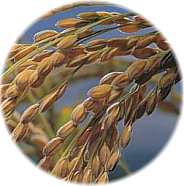|
KNOWLEDGE
Types of Sake
Making Sake
Ingredients 
Pub Guide
Sake FAQ
Sake Glossary
Sake Tasting
Serving, Storage
Vital Statistics
Free Newsletter
ARCHIVES
Newsletter Archive
Japan Times Archive
FREE NEWSLETTER
Click here to sign up
|
Rice and Sake
Prior to 1945
Rice has always been a staple part of the Japanese diet. Up until roughly 50 years ago, rice was
in short supply, with production volumes unable to meet domestic demand. Thus, the rice available for sake brewing was understandably limited, and brewing itself was confined to the winter months, when lower
temperatures and cleaner winter air provided the best conditions for brewing and storage (natural refrigeration helped keep sake fresh for consumption months after it was brewed). Such conditions made large-scale
brewing unfeasible until recent times, and resulted in regional sake brands that closely matched the local climate, cuisine, and tastes of the local population. These fairly distinct regional styles can still be
identified today.
One exception, however, is a generic type of sake produced during the Edo period (1600-1868). During this period, the new Warrior Class (samurai) had wrested power from the nobility, and
demand for sake increased dramatically amongst these warriors. Sake brewers (most notably in the Nada brewing region between Kobe and Osaka) began to produce sake with a refined flavor that appealed to these
upper-class Edo consumers. Although Nada-type sake had no overwhelmingly strong characteristics, there was nothing to dislike about it, and its appeal was therefore widespread. Interestingly enough, its appeal is
still strong today.
|
|
|
|
 Sakamai or Rice Variety Sakamai or Rice Variety
There are nine basic types of rice used to make Japanese sake, and each type yields specific flavor profiles. Keep in mind that these nine types of rice are
only part of the battle. How sake is brewed and the water used are the other parts of the story (see Ingredients). Further, there is a massive range of
styles and tremendous overlap across the board.
1. Yamada Nishiki Rice
From Hyogo, Okayama and Fukuoka. The so-called King of Sake Rice. Fragrant, well-blended soft flavor. Representative Sake Brands: About any daiginjo in the country (slight exaggeration). Hard to give one good recommendation. Nadagiku, Tatsuriki, Okuharima (all Hyogo) and Ginban (Toyama) are
good examples.
2. Omachi Rice
From Okayama. Generally less fragrant, more defined flavor elements, more earthiness. The only pure strain of rice left in Japan (to my knowledge, so don' argue for this point should you choose to quote me).
Representative Sake Brands: Bizen Sake no Hitosuji (Okayama). Most visible users of Omachi. Use it across a whole range of sake types. Lots
of it good warmed. Some fermented in Bizen-yaki tanks. Also look for Yorokobi no Izumi form Okayama.

3. Miyama Nishiki Rice
From Iwate, Akita, Yamagata, Miyagi, Fukushima, and Nagano. Slightly
less dry sake, more rice-like flavor, more mouth feel, and quiet nose. Representative Sake Brands: Sharaku (Fukushima), Hamachidori (Iwate). Both sake have great mouth/tongue feel and presence.
4. Gohyakumangoku Rice
From Niigata, Fukushima, Toyama, and Ishikawa. Smooth and clean and dry and slightly fragrant. Representative Sake Brands: Shimeharitsuru and Kubota, or just about anything from Niigata.
5. Oseto Rice
From Kagawa. Rich and earthy, very distinctive. Representative Sake Brands: Ayakiku (Kagawa). They use only Oseto rice here, in all their sake.
6. Hatta Nishiki Rice
From Hiroshima. Earthy undertones, usually in the background. Rich flavor, quite nose. Representative Sake Brands: Kamoizumi and Fukucho from Hiroshima. Two very different styles, the former being
wilder and earthy and the latter being softer and sweeter.
7. Tamazakae Rice
From Tottori and Shiga. Soft and deep, with complex background
activity when brewed right. Representative Sake Brands: Kimitsukasa (Tottori). Hard to find but at Akaoni.
8. Kame no O
From Niigata and Yamagata. Rich and flavorful and a bit drier and more acidic than other rice types, but I have not had enough to intelligently comment. Representative Sake Brands: Although there are several
across Niigata and Tohoku, look for Kame no O (Niigata, Kusumi Shuzo).

9. Dewa San San
From Yamagata and Niigata. Complex, not so dry, midly fragrant.
Representative Sake Brands: Fumitoi (Yamagata). Bottles are clearly marked with blue sticker, so easy to find Dewa 33 sake, always from Yamagata. |
|
|
|